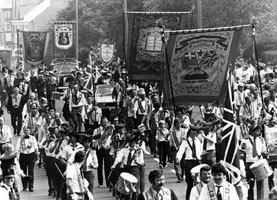17 July 2008 Edition
Remembering the Past: The nationalist nightmare

Orange march 1983
TWENTY-FIVE years ago there was much talk in political and media circles about the ‘alienation’ of the nationalist community in the Six Counties. Politicians in Leinster House and Westminster were alarmed that Sinn Féin had entered the electoral field and had significant success with consequences which could not be foreseen.
Since 1970, the Social Democratic and Labour Party (SDLP) had the nationalist electoral field to itself. Sinn Féin was banned by the British Government until 1974 and thereafter boycotted elections in the Six-County state. This policy changed in the 1980s, partly as a result of the election of prisoner candidates during the 1981 Hunger Strike.
A reorganised Sinn Féin decided to challenge the SDLP and to provide republican electoral leadership to the nationalist people of the North.
When Sinn Féin won five seats in the October 1982 Assembly elections, alarm bells rang in the corridors of power in London and Dublin. For fear of losing further support to Sinn Féin, the SDLP followed the republican party in refusing to participate in the Assembly. That body had been set up by British Secretary of State Jim Prior to provide some political cover for the British Government’s continuing campaign of armed repression.
With the SDLP out of the Assembly, the Fine Gael/Labour Government elected in the 26 Counties in November 1982 established, in May 1983, the New Ireland Forum. This was designed to give a platform to the SDLP and a firmer link with the Establishment parties in the South. But hopes of assisting the SDLP in their contest with Sinn Féin were dashed in June 1983 when the Sinn Féin vote increased in the Westminster election and Gerry Adams was elected MP for West Belfast for the first time.
FINE GAEL/LABOUR CENSORSHIP
The Dublin government did not take the opportunity to lift the Section 31 broadcasting ban on Sinn Féin nor to enter dialogue with the party. In fact, censorship and attempted isolation of republicans was intensified. Fine Gael/Labour Government ministers refused to meet local authority delegations that included Sinn Féin councillors.
The other prong of the strategy was to continue attempting to boost the SDLP through the Forum and to pay lip-service to addressing ‘nationalist grievances’.
Meanwhile, on the ground, the reality of living in a sectarian state was unchanged for nationalists. In 1983, they had to endure another orgy of loyalist violence during the Twelfth period.
In the predominantly unionist town of Ballynahinch, County Down, nationalist homes were attacked by loyalist mobs and a large family, the O’Hares, were forced to flee after their house was wrecked while the RUC stood by.
Families were also forced to leave Donemana, County Tyrone, and homes were attacked in Belfast’s Short Strand. Residents in the nationalist Tunnel area of Portadown were hemmed into their homes by the RUC and UDR as the Orange Order was allowed to parade through the area to Drumcree Church. A pregnant woman, returning to Portadown on the evening of 12 July, was assaulted by an RUC man. In Downpatrick, a young nationalist was severely beaten by loyalists who carved the letters “UVF” on his chest with a knife.
The sectarian fire was fuelled by rhetoric at Orange parades. Unionist MP Harold McCusker called for the reintroduction of hanging and urged job discrimination in favour of Protestants.
All this was to be challenged and to change in the following decade as Sinn Féin grew in strength and nationalist communities grew in confidence, but the ‘nationalist nightmare’ continued throughout the Six Counties, 25 years ago this week.
NOTE to readers: We are recommencing Remembering the Past as a weekly column. Special emphasis will be placed on events of the 1970s and 1980s, with a view to familiarising younger readers with that period. We welcome suggestions from readers for topics to be covered by the column. E-mail [email protected]


